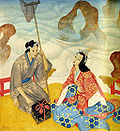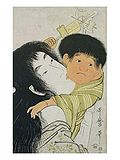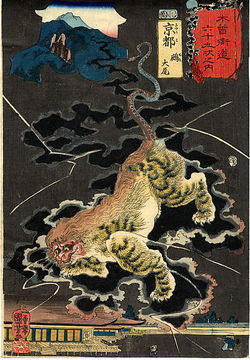- Nue
-
For other uses, see NUE (disambiguation).
A nue (鵺) is a legendary creature found in Japanese folklore. It is described as having the head of a monkey, the body of a raccoon dog, the legs of a tiger, and a snake as a tail. According to the legend, a nue can metamorphose into a black cloud and fly. Due to its appearance, it is sometimes referred to as a Japanese chimera.[1] Nue are supposed to be bringers of misfortune and illness.[2]
According to The Tale of the Heike, Emperor Konoe, the Emperor of Japan, became ill after having terrible nightmares every night, and a dark cloud appeared at two o'clock in the morning on the roof of the palace in Kyoto during the summer of 1153. The story says that the samurai Minamoto no Yorimasa staked-out the roof one night and fired an arrow into the cloud, out of which fell a dead nue. Yorimasu then supposedly sank the body in the Sea of Japan.
In a local expansion of the story, the nue's corpse floated into a certain bay, and the locals, fearing a curse, buried it. A mound near the bay which exists today is supposed to be the grave created for this nue.[3]
Etymology
The word, Nue, appears in the oldest of Japanese literature. Early quotes include Kojiki (712) and Wamyō Ruijushō (c. 934). Due to the use of Man'yōgana, the historical spelling is known to have been nuye. At this early time, although, it had a different semantic meaning. It referred to a bird known as White's Thrush.
In the thirteenth century, Heike Monogatari makes reference to a creature called a nue. In addition to having the head of a monkey, the body of a tanuki, the paws of a tiger, and a snake as a tail, it has the voice of a White's Thrush.
Around 1435, Zeami Motokiyo wrote a Noh song titled Nue dealing with the events described in Heike.
In modern fiction
- In the role-playing game Breath of Fire III, Nue was the first boss in the game.
- In popular manga and anime Bleach, the sword spirit of Abarai Renji (阿散井 恋次) is in a form of a Nue.
- Nue Houjuu from the Touhou Project series is a nue, with the ability to control the 'unknown', which results in her being able to conceal the true form of herself and other objects.
- In the 6th episode of Clannad (anime), there is Nue sculpting contest between Fuko and Sunohara.
- In the Popular Manga and Anime Air Gear, the name of the Thunder King is Nue.
- In the Nagasarete Airantō manga Nue is the number one rival of the lord of the East
- In the role-playing game series Shin Megami Tensei and its spinoffs, Nue is a recurring devil/demon .
- In the anime Harukanaru Toki no Naka de Hachiyou Shou there is a Nue in Episode 7.
- In the videogame Okami, the Chimera enemy greatly resembles the Nue, though the main body has been replaced with a kettle.
- In the .hack//G.U. series, there exist lucky animals which are small creatures with the names of mythological beasts. One of these includes a monkey like animal named a Nue.
- In the manga/anime series Nurarihyon no Mago (known as Nura: Rise of the Yokai Clan in the United States), Nue is the first offspring of the Hagoromo no Kitsune (a type of nine-tailed fox demon).
- In the manga/anime series Ga-rei the main antagonist for the first part of the series, Yomi has a Nue spiritual beast commanded by her sword.
- In the Three Part Anime(Ova) KARAS Nue(Whom is also a Yokai?) appears in Shinjuku to fight yokai.
- The Nue is a boss in the roguelike Shiren the Wanderer.
- In Michael Scott's series, " The Secrets of the Immortal Nicolas Flamel", a nue is held in a cell on Alcatraz Island.
- In the anime Mononoke (TV series) episode 08 - 09 a Nue Mononoke (or demon) is purified by the Kusuri-uri or "Medicine Seller"
- In the Super Sentai series Ninja Sentai Kakuranger the Nue is a monster featured in two episodes and is the basis for the "Hate Master" monster in season 3 of Mighty Morphin Power Rangers.
- In the game Final Fantasy XIII, The Nue is Hope Estheim's Ultimate Weapon.
- A Nue appears in Volume 5 of the manga Genju no Seiza, by Matsuri Akino; when the characters unintentionally time travel back to the Heian period in Japanese history, they are attacked by one.
References
- ^ Cavallaro, Dani. (2010). Magic as Metaphor in Anime: A Critical Study. McFarland. p. 88. ISBN 0-7864-4744-3. Google Books. Retrieved on April 26, 2011.
- ^ Rosen, Brenda. (2009). The Mythical Creatures Bible: The Definitive Guide to Legendary Beings. Sterling Pub. p. 107. ISBN 1-4027-6536-3. Google Books. Retrieved on April 26, 2011.
- ^ Nue; The Obakemono project, www.obakemono.com, 20 August 2006, (accessed 21 January 2007)
Japanese folklore 
Folktales 
Text collections Legendary creatures Categories:- Japanese legendary creatures
- Mythological hybrids
Wikimedia Foundation. 2010.

